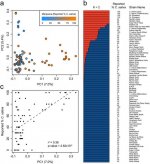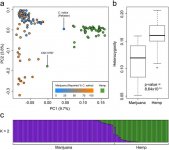clearheaded
Active member
in DJ shorts writings about breeding he says to select for hollow stemmed cultivars as they are more drug type while hemp is pith filled stems. Also Rob Clarke I do believe says similar things in his botany books. Could this be a bad assumption? or perhaps selecting hollow stemed males was to keep vigor alive by crossing 2 genetically different varieties??(less drug type X drug type=vigor but perhaps not cannibinoid %increase)
While doing some reading it appears that may actually be the exact opposite?? pith filled are drug types and hollow stems are fibre based. So this myth may have put us behind in breeding selection!! unless there is other reasons, but from what I recall him saying and in his writings I think he may have it wrong!
See pg 295. https://www.hort.purdue.edu/newcrop/ncnu02/pdf/small.pdf
"Fig. 12. Cross sections of stems at internodes of a
fiber plant (left) and of a narcotic plant (right). Fiber
cultivars have stems that are more hollow at the internodes,
i.e. less wood, since this allows more energy to
be directed into the production of bark fiber.
Love to get to the bottom of this. I realize I may catch some flack here, but i assume the researchers actually have more experience growing hemp then just drug cultivars..
Maybe Chimera can drop somethin to clear this up...
While doing some reading it appears that may actually be the exact opposite?? pith filled are drug types and hollow stems are fibre based. So this myth may have put us behind in breeding selection!! unless there is other reasons, but from what I recall him saying and in his writings I think he may have it wrong!
See pg 295. https://www.hort.purdue.edu/newcrop/ncnu02/pdf/small.pdf
"Fig. 12. Cross sections of stems at internodes of a
fiber plant (left) and of a narcotic plant (right). Fiber
cultivars have stems that are more hollow at the internodes,
i.e. less wood, since this allows more energy to
be directed into the production of bark fiber.
Love to get to the bottom of this. I realize I may catch some flack here, but i assume the researchers actually have more experience growing hemp then just drug cultivars..
Maybe Chimera can drop somethin to clear this up...
Last edited:




